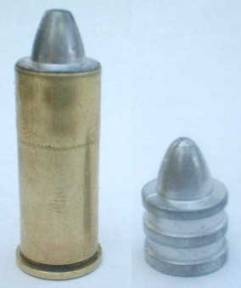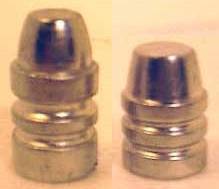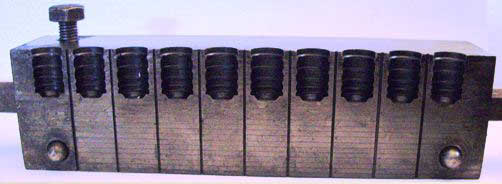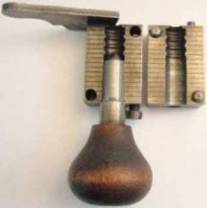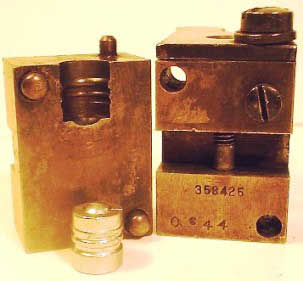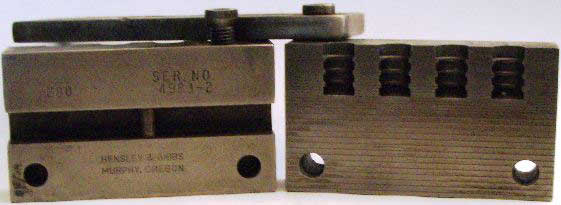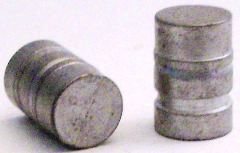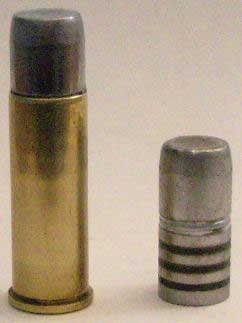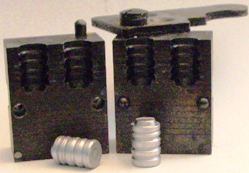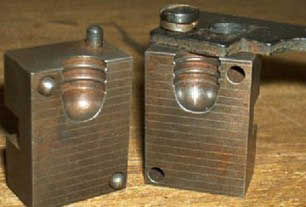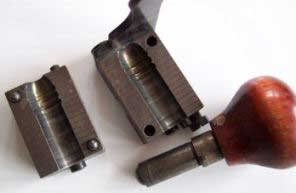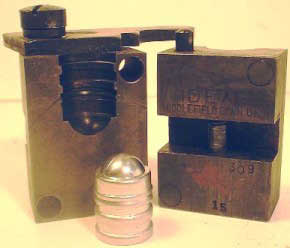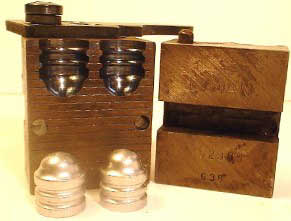|
|
|||||||||||||||||||||||||||||||||||||||||||||||||||||
|
Chapter 11 |
|||||||||||||||||||||||||||||||||||||||||||||||||||||
|
The Wadcutter |
|||||||||||||||||||||||||||||||||||||||||||||||||||||
|
OK, how many of you read the title and immediately thought, "Oh great, another re-hashing of the .38 Special..."? And your next thought was probably either "2.7 grains of Bullseye." or "3.0 grains of W231.", right? That's all well and good, but there's a whale of a lot more to the kindly old wadcutter than bullseye loads for your pet K-38 Masterpiece (you do have a pet K-38 Masterpiece, don't you?). There's a lot of fertile ground here, so let's go back and start at the beginning. History of competitive pistol marksmanship and the role of the wadcutter Competitive marksmanship has been around ever since that second caveman learned how to throw a rock. It's simple human nature that he take his newfound skill and challenge the first rock-throwing caveman to see who could throw their rock more accurately, or farther, or who could throw the bigger rock, or hit a moving target, or be the first to knock over yonder rotten stump (you know, the pretty much same games we play today with guns). As new technologies appeared, these primitive competitions evolved to keep pace, and assimilated weapon systems like slings, spears, atl-atl's, boomerangs, bolos, throwing knives and axes, short bows, long-bows, crossbows, handcannons, muskets, rifles, pistols and shotguns. It's entertaining to recognize that skeet, IPSC, basketball, hockey and golf all share this common origin -- all are manually directed competitive events with the goal of placing a projectile on a remote target. Even events like the javelin, discus and shot-put are related to archery flight shooting as a distance competition, and bowling and silhouette shooting are related by the need for accurate placement of the projectile with sufficient force to knock their targets down. Our history as warriors and hunter/gatherers is apparent from the games we devise today; whether Frisbee golf, lawn darts, Olympic archery, baseball or bullseye competition, we as a species are obsessed with the accurate placement of a projectile on a distant target. Such marksmanship competitions undoubtedly started off as simple, informal affairs, much like current day plinking ("Betcha can't hit that pine cone!"). However, because of the vital importance of the hunter/warrior's marksmanship skills to early societies, these competitions soon became important affairs, with the pomp and pageantry befitting a hero, because these were public demonstrations of the skills that would create heroes, both on the battlefield and by providing protein to hungry families. Quite simply, the ability to shoot well was a commodity that was valued and respected by the surrounding community. Human society has always valued marksmanship, and surrounded marksmanship skills with ceremony and respect. The Old Testament tells us the story of David and Goliath, in which the precise placement of a single projectile slew the fearsome giant. Formal archery training and competition is depicted in ancient Egyptian paintings, dating back to before 1500 BC. The Chinese philosopher Confucius (born in 551 BC) was schooled in the art of the bow and organized classes in archery for all of society, and has been quoted as saying, "By the drawing of the bow one can know the virtue and conduct of men." (think about that for a minute). Stone markers, ornately carved in marble still stand where arrows landed long ago in medieval flight shooting competitions outside of Istanbul (the Turks were highly regarded for their exceptional archery skills). In medieval England, obligatory marksmanship practice and regular competitions were royally decreed, and failure to participate was punished by imprisonment. In 1520, Henry VIII of England staged a magnificent show of arms called "The Field of Cloth of Gold" where he "cleft the mark in the middle and surpassed them all". These are just a few testimonials to the importance that each of these societies placed on the shooting skills of a man to hit a distant mark. While the military significance of the longbow has decayed since the Middle Ages, the social importance of marksmanship has not. Through the 1800s toxophilites (archery enthusiasts) continued to organize large, formal archery contests "at the butts". About this time, other groups of shooters also started having gala social shooting events. Often these were ornate, formal dress, multi-day affairs, with engraved invitations, and focused on shooting skills with a variety of guns, particularly rifles and shotguns. Firearm technology evolved rapidly in the last half of the 19th century, transitioning from muzzle-loaders to cartridge loaded repeating arms. Handgun design went from cap-n-ball revolvers to double action revolvers and autoloading pistols. Once again, as technology evolved, so did the format of marksmanship competition. For the first time in history the skill of a shooter armed only with a handgun was viewed as more than the stuff of last ditch combat gallantry, and was now gaining recognition as grounds for serious (and socially valued) competition. Smith & Wesson had been interested in manufacturing a large caliber, cartridge firing revolver throughout the 1860's, but the Civil War, as well as a variety of design problems and patent licensing issues, slowed their entry into this market. The S&W Model No. 3 (i.e. large frame break-top), patented in 1869 with production starting in 1870, would be a harbinger of the birth of bullseye pistol competition. In 1871, Russian General Alexander Gorloff ordered 20,000 Model No. 3's for the Russian Army, requesting a number of modifications to the standard design and that they be chambered for a new "inside lubricated" centerfire cartridge that was to become known as the ".44 S&W Russian". The pocket revolver had established S&W as a viable American manufacturing enterprise, but the large framed Model No. 3 cemented S&W's reputation as a major international arms producer. Over the next several years, various design changes were incorporated into these guns and additional production runs were sold to the Russian Army, eventually totaling over 130,000 guns. S&W was also selling variations of the Model No. 3 at a brisk pace here in the States. These guns were offered in a variety of chamberings, but the .44 caliber guns were the most popular (.44 Henry Rimfire, .44/100 centerfire and .44 S&W Russian). The New Model No. 3 .44 Single Action was unveiled in 1878 and made enough of a splash that its manufacture was featured on the cover of Scientific American (January 24, 1880). The first revolver designed and built specifically for competitive target shooting was the S&W New Model No. 3 Target developed in 1886, inspired by a group of pistol shooters who competed regularly in a 100-shot match. Bullseye pistol competition had been born. Chevalier Ira Paine set a record of 791 points (out of 1000 possible) on October 15, 1886 using a S&W New Model No. 3 in .44 S&W Russian, and then later bested his own mark with an 841 (March 17, 1887). Later, on November 4 of that same year, F. E. Bennett set a new record with a score of 857. Serious competition grew at these pistol matches, and public interest grew as well. The shooting industry was quick to take notice, and S&W quickly offered their Model No. 3 chambered in the inside lubricated .32-44 and .38-44 cartridges, specifically for such target competition. However, in the long run, the .44 S&W Russian chambering was by far the most popular with the competitive target shooters. As an aside, this new form of pistol competition was one-handed shooting since traditionally the handgun was an officer's weapon, and an officer (of course) was mounted, so he had to use his non-shooting hand to hold the reins of his horse! The one-handed pistol form was retained in military training since in combat the shooter might be wounded and only have one good hand. Thus, NRA bullseye pistol competition was born with its left thumb hooked under its belt. Initially, the bullets used in these pistol matches were simply the standard 246 grain lead round nose .44 S&W Russian offered by the factories, or cast by the competitors. Unfortunately, these bullets, while superbly accurate, did not cut clean or full-diameter holes in the target, which made accurate scoring problematic and missed points a very real possibility. Competition grade guns and shooters had arrived, it was time for the bullets to catch up. There were 146 mould designs listed in the Ideal Handbook #9 (1897) and not one of them was a wadcutter; all of the pistol bullets listed were either round-nosed, or round-nose flat-points. The original wadcutter made specifically for competitive target shooting was the Himmelwright wadcutter (Ideal #429220), which was unveiled in 1900 (and cataloged up through HB #39, 1953 and listed in the Handbook of Cast Bullets, 1958). This bizarrely shaped bullet was designed to cleanly cut full diameter holes in the target to make accurate scoring of target a snap, but also to have enough of an ogival nose to insure stable, aerodynamic bullet flight. This unique projectile was specifically designed for the S&W Model No. 3 chambered for the .44 S&W Russian (the .44 S&W American used an outside lubricated, heel-type bullet and the .44 S&W Special would not be introduced for another 7 years).
The next wadcutters on the scene were J. B. Crabtree's Ideal 360345 in 1903, B. F. Wilder's Ideal 360271 in 1904 and Himmelwright's Ideal 360302 in 1905, primarily designed for the .38 S&W, as well as the newly introduced .38 Special. Today, we would call the Crabtree and Wilder bullet "semi-wadcutters" to differentiate them from the cylindrical bullets we call wadcutters today, but the era of the wadcutter had just dawned and this distinction hadn't yet been drawn in 1905 (these two bullets were still labeled as wadcutters in the Ideal Handbook #37, circa 1953; the term "semi-wadcutter" doesn't seem to have gained general usage until the mid-to-late 1950s, and was used in the Handbook of Cast Bullets in 1958 to describe the 358480, 452460 and a couple of other similar bullets, but interestingly enough, was not applied to either the Keith or Thompson bullets, those most commonly associated with the term today). Wadcutter experimentation continued, primarily focused on the effect of nose profile on bullet stability and accurate flight, with the dome-topped 454309 and square-nosed 360344 (150 grain), 429348 (180 grains) and M. L. Holman's 429352 (245 grains), all of which came out during this same time frame. The Peters Cartridge Company was the first to produce factory loaded wadcutter ammunition in or around 1914. In 1915, Ed McGivern designed an experimental hollow-based wadcutter mould that he commissioned Ideal (then owned by Marlin) to make. McGivern's bullet would eventually be known as the Ideal #358395. The incorporation of a hollow base into the wadcutter is not surprising since the wadcutter was designed explicitly as a target bullet and the hollow-base design was (mythically) believed to be inherently more accurate. In 1919, McGivern, along with Phineas Talcott (remember Phineas? he was the owner of Ideal from about 1918-1925) and several Remington engineers tested this bullet extensively.
It performed so well that Remington adopted is as part of its ammunition line, and Western Cartridge Company followed shortly thereafter in 1920. Bullseye pistol competition had definitely caught on and a great deal of work was put into the developmental of bullets and ammunition specifically designed for this pastime. As an aside, it is interesting to note that in 1897 Ideal had 146 bullet designs, and in 1915 they were assigning cherry number 395. In less than 18 years, they had added approximately
250 bullet designs to their line, and most of these new numbers came about between about 1900 and 1905! Also, keep in mind that a
number of the original cherry numbers (particularly those of the round ball moulds) were recycled, making the total number of new cherries even higher than this simple analysis would suggest. John Barlow, and Marlin, were clearly being aggressive in serving the needs of the shooting public during this timeframe. After Lyman bought Ideal in 1925, the evolution of the wadcutter continued, first with the dainty 112 grain 358425 (1930), and the somewhat more robust 160 grain 358432 (1931?). The pinnacle of the target wadcutter design was achieved in the early-1930s with the now familiar design settled on by George Hensley as his classic #50 (which Lyman later emulated with their 358495 in 1955).
Obviously, one of the principal design features of the wadcutter is to cut full diameter holes in the target for easier and more precise scoring in bullseye competition. However, there are also several other aspects of the wadcutter that are commonly overlooked. Wadcutters are generally designed to be deeply seated in the cartridge case to eat up case capacity, to produce better uniformity with the light powder charges used for target loads. The wadcutter also generally has extensive bearing surface that provides better alignment in the throat and forcing cone of a revolver, thereby favoring concentric engraving, and better short range accuracy (before the lousy aerodynamics of the "flying trash can" destabilize the bullet and ruin flight stability). Gil Sengel wrote up a nice little piece on wadcutters in the Jan/Feb 1990 issue of Handloader magazine (#143), and he coined a terminology to differentiate between different styles of wadcutter based on how deeply they we seated in the case (or more accurately how much was left sticking out of it).
Type I wadcutter. A Type I wadcutter has no crimp groove, only lube grooves, and is seated entirely within the case. If a crimp is to be applied on a Type I wadcutter, it is applied over the nose of the bullet. The primary application of this bullet is in semi-automatic bullseye guns like the S&W Model 52 and the Colt 1911 National Match .38 Special Gold Cup. These guns require the wadcutter to be fully seated within the case for reliable cycling of the action. Perhaps the best known example of a Type I wadcutter is the Lyman 358063, introduced in 1963 in response to demand from bullseye shooters competing with custom made 1911s chambered in .38 Special and .38 AMP, the S&W Model 52 (introduced in 1961), and the Colt 1911 National Match .38 Special Gold Cup Mid-Range. This bullet design was the direct result of the popularity of these guns and bullseye competition. (As an aside, cherry #63 is a recycled cherry number, the original being a round ball for the .32-44 S&W Gallery). Successful loading of these bullets requires that seating and crimping be performed in separate steps. These same issues apply to the target pistols built for the .32 S&W Long. These semi-auto target guns made by Walther, Pardini-Fiocchi, Erma, and others are specifically chambered for the .32 S&W Long loaded with deeply seated Type I wadcutters.
Type II wadcutter. It's easier to seat the bullet with one driving band outside of the case and to crimp using a traditional crimp groove, thereby allowing seating and crimping to be performed in a single stroke, and historically this is how wadcutters have been most often employed. This is the design that is most commonly encountered (and thought of) today when one mentions the terms "wadcutter". The classic example of a Type II wadcutter is H&G #50 or Lyman 358495. These bullets have 3 grease grooves, followed by a crimp groove, one driving band and a small "button nose". This design provides all of the advantages of the Type I (deep seating, wadcutting ogive, full-length bearing surface, etc.) but it also allows for easier and more uniform seating and crimping. For over 3/4 of a century, this bullet design has established itself as the definitive bullseye pistol competition bullet. Moulds for the Type II wadcutters have been made in virtually all of the common revolver calibers, and in a variety of bullet weights. Loaded to 900 fps or so, these bullets make excellent small game hunting loads. The Lyman 358495 over 4.5 grains of W231 for 950 fps is a personal favorite for such activities. That cute little vestigial nose left on these Type II wadcutters is intended to provide additional aerodynamic stability by breaking up the air-flow and starting the slipstream. Since these are virtually always subsonic bullets (not only sub-sonic, but below 0.85 Mach, or roughly 900 fps), the airstream is roughly conformal to the bullet's profile, with turbulent flow in the boundary layer at these velocities. There is no super-sonic "bow-wave". A flat face with a sharp shoulder (e.g. Ideal 358348) can induce substantial turbulence just aft of the shoulder. This is because the slipstream is unable to flow smoothly around a sharp 90 degree corner, so there are turbulent "eddies" formed just aft of this shoulder, which can destabilize the spinning wadcutter and lead to tumbling. By putting a small nose just forward of the flat face, the airflow is more gradually redirected as a result of the eddies formed along the sides of the nose, resulting in somewhat greater stability in flight, and therefore longer accurate range before the wadcutter starts to tumble.This "aerodynamic re-direction concept" was most pronounced in the Himmelwright wadcutters, and tapered off with subsequent designs. Since virtually all bullseye shooting is done inside of 50 yards, that's all the accurate range that's needed from a wadcutter target load, so the extended proboscis of the Himmelwright wadcutter really isn't necessary. Because of the complexity this proboscis adds to the seating/crimping step, it was simplified (or dropped altogether) in subsequent wadcutter designs.
There were also a number of very lightweight Type II wadcutters that were made for the very light loads used in gallery (or "parlor") target shooting. An example of this kind of bullet would be the Ideal 358101 (this is another recycled cherry number, the original was a .424" RB). Looking at this bullet, I have to wonder if the conversation surrounding its genesis didn't start out something along the lines of, "Hey! Wouldn't it be neat if...." This 77 grain bullet was presumably originally designed for light gallery loads, but I suspect it may have also found application in discrete urban rodent control. Similar lightweight wadcutters, such as the H&G #239 (.44 caliber, 200 grains), and H&G #155 (.45 caliber, 200 grains) have also been produced. Type III wadcutter. The Type III WC was intended to extend the WC's
capabilities to the hunting fields by seating the bullet out of the case to more typical SWC seating depths. By seating it out of the case there is more capacity for powder and pressures of full-velocity loads are kept moderate. For this reason it is sometimes referred to as a "full-velocity wadcutter". Long range stability is still a problem with these bullets, but they can be very effective hunting bullets at modest ranges. 313492, 358344, 429352 Ogival Wadcutters. In recent years, LBT and NEI have marketed moulds they have called "ogival wadcutters" which combine the Type III concept with a very small amount of curvature added to the ogive to improve the WC's flight characteristics without sacrificing too much meplat. This was a revision of an old idea that had been around for many decades, originally being captured in early Frankford Arsenal bullet designs (circa 1890). The Frankford Arsenal bullet was for police use, back in the days (in the words of one ballistic historian), "when the police actually shot bad guys with the hopes of killing them". For those PD's using service revolvers, the ogival wadcutter makes a great deal of sense in that close range lethality is great, while the bullets will generally start tumbling inside of 100 yards, rapidly losing velocity/energy in the event of an errant shot, thereby minimizing risk to innocents.
In any event, in more recent years the focus of the ogival wadcutter has been more on hunting applications, where these bullets serve admirably, although they have a limited effective range due to poor flight stability. While most handgun hunters are perfectly content to limit themselves to moderate ranges before they shoot, it's important to recognize the limited value of a bullet that can't be relied upon to finish off a rapidly departing wounded game animal before it gets out of range, should the first shot not prove quickly fatal. There are a number of excellent hunting designs (Keith, SSK, LBT, etc.) that allow a skilled handgunner precise bullet placement at extended revolver ranges, thereby allowing such a cripple to be finished off in a responsible and humane fashion. The ogival
wadcutter, although a short-range sledgehammer, can't be relied on to finish off an outward bound cripple before it escapes, due to the ogival wadcutter's poor long range accuracy, leading to the possibility of a long, and perhaps fruitless tracking job. In heavy brush or black timber, such a follow up shot is unlikely anyway and shot opportunities will be at close range, allowing precise first shot placement. The ogival wadcutter would be right at home in "the thick stuff", like one encounters when hunting feral hogs, but could be a poor choice on the plains of Wyoming for hunting antelope. Base design Which is better, plain-based wadcutters or bevel-based? Are hollow-based wadcutters really more accurate than solid bullets, or not? Why doesn't anybody make gas-checked wadcutter moulds? Let's examine these issues, one at a time. Originally, wadcutters were plain-based (PB). The reason some folks wanted to put a beveled base on their wadcutters was to facilitate the loading process. This is a significant concern if you're a junior officer on the local PD, stuck at the loading bench on a sunny Saturday and you can't leave until you have a couple thousand rounds loaded for your departments' qualification course next week. Bevel-based bullets also tend to drop more easily from the mould, expediting the casting process. As the bevel-based wadcutter gained acceptance, some shooters claimed that they were in fact more accurate than their plain-based cousins. Detailed testing (see for example John Zemanek's article in Handloader #161, Jan/Feb 1993, or E. H. Harrison's article on "Making Accurate .38 Handloads" in NRA Handloading) suggests that in certain guns the bevel-based wadcutters are indeed slightly more accurate than plain-based wadcutters. However, it is important to point out (as both authors do) that in certain other guns the reverse is true. In my own extensive testing on this subject I can find no significant difference between the two, both shoot very well out of my guns. What's more, I have found no significant advantage to using cast hollow-based wadcutters over solid based wadcutters. I have hollow-based moulds for .38, .41, .44 and .45 caliber wadcutters, and while these bullets shoot just fine, there is nothing to recommend them over other target loads that I assemble using solid-based wadcutters (either plain-based or bevel based). Commercial hollow-based wadcutters are also quite accurate. This is only partly due to their being hollow-based (which makes sizing less important since they will swell to fit the bore when fired), but also due to the fact that they're formed under high pressure and therefore have no voids. It is important to remember that swaged hollow-based wadcutters must be limited to mild pressure loads to prevent "popping the cork" and leaving a lead sleeve in the bore of your revolver. As for gas-checked wadcutters, this is an experiment that was tried many years ago and their virtually complete absence today makes it pretty obvious that the final conclusion was, “Why bother?”. If you have a GC wadcutter mould, you have a unique conversation piece, and quite likely a collector’s item. Target bullets need to be accurate and they need to be produced in large quantities; adding a gas-check didn’t help the accuracy and slowed down the production rate, leaving the project to die an ignoble death. May it rest in peace.
The bottom line is that there's nothing wrong with shooting bevel-based or hollow-based cast wadcutters, but there's no evidence to indicate that either is more universally accurate than the plain-based wadcutter. The hollow-based wadcutter is considerably slower to produce than the plain-based wadcutter, and both the bevel-based and hollow-based wadcutters are best limited to moderate pressure loads since the hollow-based wadcutter gives poor accuracy (and marginal safety) at higher pressures, and bevel-based bullets can lead to cylinder gap leading at higher pressures. The plain-based wadcutter is every bit as accurate as it hollow-based and bevel-based brethren, and more versatile than both since it's not limited to mid-range loads and can be loaded to full-velocity. For mid-range target loads all three are equally capable of fine accuracy at moderate ranges.
Wadcutters in the field While I have used many, many .38 wadcutters for bullseye practice and competition, perhaps my favorite use of wadcutters is found in hunting small game with a .32 S&W Long. I have used all manner of .32 wadcutters in these guns (RCBS, NEI, H&G), and they all shoot remarkably well over 2.0 grains of Bullseye, but for use in the hunting fields I prefer the Lyman 313492 (Type III wadcutter), which weighs about 90 grains when cast of WW alloy. Seated on top of 2.5 grains of Red Dot, this little pill generates about 950 fps with excellent accuracy, and it hits small game hard at moderate ranges, but without excessive meat damage. This load is well suited for shooting bushytails in the treetops as the inherent instability of the flat-nosed wadcutter shape (as well as contact with leaves and branches) will have this little wadcutter tumbling, and rapidly losing velocity, in short order. A pleasant afternoon stroll, with a favorite .32 S&W Long revolver, in pursuit of small game is an excellent way to shake off the tensions of modern life. The wadcutter is indeed the bullet of champions. The importance of the wadcutter to PPC and bullseye pistol competition is emphasized in the writings of champion pistol shooters like Jim Clark and Gil Hebard. To achieve master class proficiency, these shooters have sent literally tons of wadcutters downrange. The social ceremony of marksmanship continues to this day in the National Matches at Camp Perry, national PPC matches, Olympic competition and events like the Bianchi Cup, and for the pistol shooter the prestige of these matches is borne on the back of the workhorse wadcutter. The ability to shoot well is still a valuable commodity, to both the individual and to society. But the wadcutter is not merely a match bullet, it also finds application in very light gallery loads, vermin control, law enforcement, and as a short-range hunting bullet in the thick stuff. Surprising versatility for such a specialized bullet. |
|||||||||||||||||||||||||||||||||||||||||||||||||||||
|
|
|||||||||||||||||||||||||||||||||||||||||||||||||||||
| Table of Contents | Continue to Chapter 12 - The Keith Semiwadcutter (SWC) | ||||||||||||||||||||||||||||||||||||||||||||||||||||
| Index of Additional Glen E. Fryxell Shooting Articles | |||||||||||||||||||||||||||||||||||||||||||||||||||||
